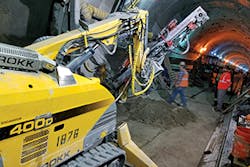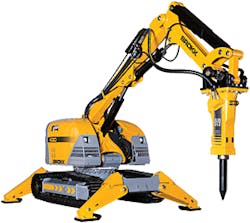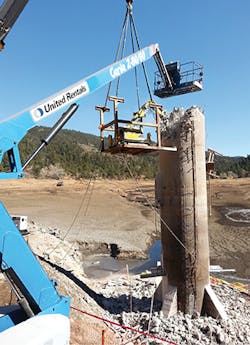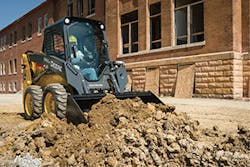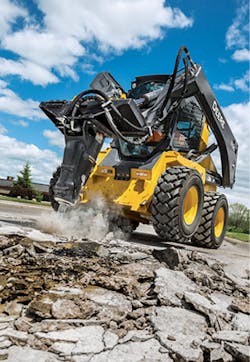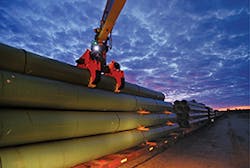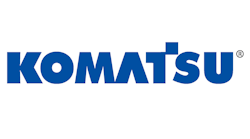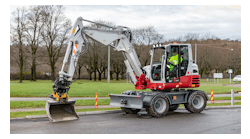Almost everyone has had the experience where frustration with the inefficiency of a tool or machine prompts the request to the universe: “If only someone invented a tool that could do this better I’d be done by now.” In heavy equipment when time is money this is especially true, but sometimes innovation is driven by a need more crucial than efficiency: safety.
Replacing the Human Deckhands
While working in the rigorous environment of horizontal drilling and pipeline construction, Jason LaValley, founder and CEO of LaValley Industries, learned more than he bargained for. He says every day he was constantly aware of the human physical and mechanical challenges posed by drilling, handling, and connecting pipe.
Moreover, he was keenly aware of the safety risks his workers were exposed to on a daily basis. “We were working, literally, as human deckhands, loading, and unloading pipe in all kinds of weather and all kinds of conditions. These pipes are big, heavy, and unwieldy; it’s a dangerous job that requires constant vigilance to personal safety. Yet, even under the best intentions to stay safe, accidents happened. I saw so many injuries—guys with pinched fingers, broken hands, broken legs—it was terrible.”
With current automation technology accelerating at record pace, LaValley was baffled that workers in the 21st century were performing tasks with little more efficiency than that of 19th century miners.
He describes how one event was the turning point that changed everything.
After witnessing one particularly tragic accident where a man’s ankle was crushed, LaValley was more than motivated to solve the deckhand problem. “That same night I drew up a design sketch that let equipment, not people, do the job. The concept sketch then became the genesis for the LaValley Deckhand,” he explains.
This invention launched the Minnesota-based LaValley Industries in 2006, “and was the first invention in our line of attachments for excavators. The Deckhand has interchangeable and customizable arms and mounts to any brand of excavator,” he says.
He adds that it can grab anything from 4-inch-, to 56-inch-diameter pipe, and comes equipped with special wear pads that protect pipe coating from scratches and gouges. “The way it works is the operator in the cab uses a joystick function to maneuver the Deckhand. Plus, with its integrated safety features such as load control valves, the pipe is never dropped, regardless of the hydraulic pressure.”
LaValley says you can use the Deckhand for “any application where you need to pick up something, not just pipes—steel, concrete, whatever you need to move. The lift is absolutely secure; there’s no swinging or lateral movement; the operator controls every move from inside the cab.”
Best of all, risk to workers is vastly reduced and job time to move material is reduced making Deckhand an all-around asset to any construction site.
LaValley says innovation didn’t stop there. Leveraging his inside experience with horizontal drilling he explains that there is a huge dilemma of exit side operations. “For example, when drilling under a river or roadway, the drill rig rotates the drill rod when boring, but when you get to the other side, how do you get the drill rod apart?”
With the TONGHAND exit side wrench, he says, that he invented for exactly this purpose.
He nicknames this attachment the “Rig on a Stick,” explaining that it can be used as a vise and pipe handler to easily make and break pipe joints up to 120,000 foot-pounds of torque.
And like the Deckhand it can be attached to any brand of 30- to 36-metric-ton excavator. “The TONGHAND has patented roller arms and shift function so you can both thread and unthread all drill pipe connections from inside the excavator. This attachment can do the job in a fraction of the time it would take workers to complete it by hand all while reducing the risk of injury in handling.”
LaValley’s excavation attachments bring several applications to the construction industry arena including horizontal directional drilling, pipe stringing, pipe removal, and utility work “to name a few,” he says.
While he concedes that there are other products on the market, he says that he brings a unique perspective to his line of attachments. “I’ve worked the day-to-day in this industry; I’ve seen the hardships, the safety hazards, and the efficiency problems closeup. When I design new products, I try to address all these issues to meet the needs of the people who do this demanding work everyday.”
Brokk 400
Making Tight Spaces a Snap
Faced with a demolition task when everything is too big, too small, too unwieldy, or too dangerous, operators can well appreciate the precision technology alternative of demolition innovators, Brokk Inc. Company spokesperson Peter Bigwood says Brokk has been the leading manufacturer of remote-controlled demolition machines for over 40 years, and explains the perfect pairing of their machines ability with their name of its Scandinavian origin.
“Brokk was the mythical figure—a dwarf—who forged the hammer for Thor, the god of war in Norse tradition,” says Bigwood, adding that while Brokk was a diminutive character, he was “very strong, just like our machines.”
The remote controlled Brokk is inarguably the perfect choice for many construction applications and Bigwood says that operators have more than 70 Brokk attachments to suit almost any demolition scenario. These attachments can greatly expand the functionality and application of the small-but-tough machines by deploying a variety of breakers, side angling devices, crushers, shears, grapples, buckets, and more.
“And all our machines are remote controlled which means you can use them in really tough and challenging conditions where large machinery with sufficient power is needed, but there is awkward access, space limitations, potential safety hazards for the operators that don’t allow their use.”
As example, Bigwood describes how a recent demolition of concrete silos in New Mexico, a “very tricky project,” was successfully accomplished by a Brokk machine equipped with a hydraulic breaker. “These 65-foot-plus-tall silos were alarmingly close to the Santa Fe municipal water supply, but they were from the 1940s and needed to come down.”
The Brokk 330 in suspended demolition
And, Bigwood explains that this type of challenge is where the capability of their machine specialty can take center stage. “Due to their location, we couldn’t risk excessive use of force. It was a tricky job as these are located in the Nichols and McClure reservoirs on the Santa Fe River, the source for more than 40% of the municipality’s drinking water. ”
He says that city engineers came up with the required $6 million needed to carry out their plan that would demolish the existing silos, but retain the inlet structures at their base, allowing inlet renovation. But it had to be done carefully, so it was a job perfectly suited for the Brokk 330D, a diesel powered demolition robot. This unit, which was secured to a platform, and suspended by crane, was then controlled by wireless remote by an operator who was located on his own nearby crane lift platform. “The operator could manage the demolition bit by bit with visual observation, and in total safety.”
“We had to be extremely careful to have enough force to take down the 10-foot-diameter and 2.5-foot-thick concrete walled silo that was reinforced with rebar, steel plates, angle iron and embedded valve gates. This Brokk machine used about 700 foot-pounds of power to carefully break away the 65-foot-tall structure in small pieces, rather than just smashing it into huge bits.”
Bigwood explains the way it works. “There is a belly box that goes around the waist of the operator who uses two joysticks for the remote control features.”
There are also some extra toggle switches and other robotic controls that he says allow “more than you can do with a typical excavator.
“People ask ‘how far away can you be from the demolition?’ and we tell them you can be a football field away, but realistically you should be closer to see what’s going on.”
“If you have ever driven in tunnels you’ll notice doors on the walls; these doors lead through a small tunnel to the opposing traffic side. These are required for safety reasons, in the event of a fire or other accident.
When you are actually digging that “mini-tunnel” from one side to the next, there is often a risk of a cave-in. So, first thing when making cross passages is to use a diamond blade to cut a large opening through the 1- to 2-foot-thick concrete wall of the main tunnel. Then, deploy the Brokk hammer attachment and carefully break out the concrete in small pieces.
“Now, you have dirt in front of you, so you put on the shovel attachment and start excavating this mini -tunnel. Once this is done, you use other attachments and dig that little tunnel to become 10 or 12 feet high; the small size of the machine is perfectly suited for this. Then, the guys can go in and build the reinforcement. And, here you can use the Brokk beam manipulator to lift those curved steel beams into place while they’re being welded or bolted together.
The company started with a 2-ton model and now they have seven models comprising a half-ton to the biggest, which is 12 tons. With options to attach machine-mounted cameras, the workers can do their job at a safe distance.
John Deere’s G-Series design improves users productivity and enhances visibility.
“In nuclear work for example, you definitely want to be far away, but still be able to see the details of the operation. We have an attachment for example, that can pick up a train track, and we can customize an attachment to modify it for a specific job, like our carbide tipped drum cutter for materials that are too hard to dig with a conventional tool.”
Plus, for jobs in tight spaces, the small unit that weighs only 1,100 pounds can fit on a truck, but has an 8-foot reach and hits harder than a 90-pound jackhammer, which saves the crew wear-and-tear from manual demolition. “Our attachments and robotic remote controlled systems do the dangerous stuff to help increase safety and lower risk on just about every project.”
He says these days it’s harder to get young people to do dangerous jobs, and with the extensive robotic capabilities of the Brokk range and its attachments, people can direct the machines to do the heavy lifting, quickly and safely.
Attachment Specialists for Productivity and Safety
One look at AMI Attachments’ website and their slogan, “It’s not a job, it’s a performance,” says it all. Their visuals of machines in action can easily evoke a science fiction film with the AMI Attachments resembling Transformers on steroids that appear onsite to save the day.
Spokesperson Jeff Brubacher concurs that these dynamics are accurate, and reflect how AMI Attachments is a hotbed of attachment innovation, “producing quality, reliable attachments for excavators, backhoes, wheel loaders, and other heavy construction equipment.” Through their Ontario head office and manufacturing facility AMI Attachments serves the heavy equipment attachment market across Canada and the United States.
“We’ve been doing attachments since 2001 and are always coming up with new and different attachments, for both specialty markets, and increasing the productivity and efficiency general excavation contracting,” says Brubacher.
One of the latest innovations is their ISO safety compliant pin-grab quick-coupler unit, which he explains is a “big deal for global use.
“A new ISO safety standard, 13031, will affect how equipment used meets this new safety standard. Even though there are currently no US policies in place for compliance violation in the US—operators have two years to accommodate the ruling for their equipment—it’s better to think about it now, rather than later,” suggests Brubacher.
He describes how the latest innovation, AMI’s hydraulic pin grab coupler (disconnect) meets this ISO safety requirement. Brubacher says this attachment connects and disconnects buckets safely and easily and eliminates the risk of workers not using the safety lock whether due to negligence or forgetfulness.
“What’s great about this is, if you want to safely switch attachments quickly, you can do it right from the cab. So, you can go from a digging bucket to a ditching bucket or grapple.
He outlines how the AMI hydraulic pin-grab quick coupler includes five safety features and keeps the operator within the safety and weather protection of the cab at all times. First, “You have to turn on the switch and then hold a button down for five seconds. There is continuous audio alarm and a flashing light to alert the operator of status.”
Since the coupler requires full system pressure to disconnect, only when the bucket is fully curled is this achieved. This provides a safe position for the bucket to be released.
“The main locking cylinder inside the AMI hydraulic pin-grab coupler features a load-holding valve which maintains system pressure in the event of pressure loss,” explains Brubacher. “In the case of a ruptured hydraulic line, the coupler will remain locked because it requires full system pressure to release.”
Part of the ISO safety compliance, the coupler must have a safety lock that secures both pins. Not only does the AMI pin grab coupler offer this level of safety, but it removes the responsibility of the operator to physically insert a safety pin.
“The one-way hydraulic cylinder is spring-loaded, mechanically forcing the safety lock closed,” says Brubacher.
During the process there is an intermittent audio alarm alert that only goes off he says, when the disengagement switch is turned off.
These multiple safety features, Brubacher says make it one of the few couplers that are compliant with the ISO safety standard, “and with dedicated hydraulic lines, the hoses and valve that tie into the machine’s main pump keep auxiliary ports available.
He adds that AMI innovation is about efficiency, but that safety is paramount. “When designing these systems we take into account not just the mechanical operations but the behavior of people. The hydraulic Pin Grab fits the standard factory pin lugging of machines to offer safety features that like our website says, ‘keeps you working without worrying.'”
Offering a full line of attachments “AMI has everything for the excavator,” including demolition and sorting grapples, concrete pulverizers, and pavement edgers for road maintenance. Brubacher says their tilting and rotary buckets help operators reach awkward spots with less repositioning.
He describes the Tilting bucket as having the ability to perform 90-degree rotation, and the Rotary Tilting Bucket with 180 degrees using a helical actuator. “The Tilting bucket has the flexibility allowed by the design of no exposed cylinders or hoses and has a 90-degree tilt range on each side, perfect for tight spaces, slopes and complex removal demands.”
In fact, this might almost remind you of the complex dexterity of your hand and wrist since, “it can pick up, turn, and tilt with precision in just about any direction for any application.”
The LaValley Deckhand at work
Advances in Adaptability
You don’t get to be the largest equipment rental company in the world without a lot of hard work, excellence in service, and a huge range of offerings to answer every equipment rental need. Which is just what Stamford, CT-based United Rentals Inc achieves. According to Brent Kuchynka, vice president of Corporate Fleet Management, United Rentals offers their customers 3,200 classes of equipment that serve the needs of construction and industrial customers along with utilities, municipalities, homeowners, and others.
He describes the most popular dirt attachment are buckets in a variety of sizes along with hydraulic breakers, posthole augers, sweepers and planers. But there’s been a significant shift in how these attachments serve the market.
He observes that the latest technologies are not necessarily “the attachments themselves, but rather the adaptability that has evolved to accommodate different brands of equipment.
“Years ago, the majority of attachments were manufacturer-specific. An attachment would only work with dirt equipment—excavators, backhoes, and skidsteers—from the same brand. The innovation of quick couplers with a single pin meant that a bucket or attachment could be used on equipment from multiple manufacturers.”
Kuchynka says the new pin couplings are an improvement that “helps operators get the job done.”
Describing that some buckets are best for digging, while some are intended for dirt removal and hauling, he adds that “Hydraulic breakers are typically for breaking concrete, but there’s also a ripper-type bucket that can cut through soil that is highly concentrated with rock, and so on. But with quick coupling, contractors are more likely to use the proper attachment for each task because it’s faster and easier to swap them out.”
And this, Kuchynka says, has “been transformative.” He explains how the adaptability has improved the turnaround time of changing out attachments, “but in our case, this benefits the rental prep process and makes contractors more productive onsite.
“The new coupling designs have also improved the safety aspect for operators because they reduce the manual labor required to change out attachments.”
And, he affirms that investing in these attachments is a good one for their company. Since the availability of standardized equipment, the need for a number of redundant attachments that were formerly mandatory to accommodate their multiple brands of equipment has been reduced.
“This in turn lowers costs and cuts labor time during attachment changes by half. Another benefit he describes is that the innovations have become more ergonomically designed which makes it safer and lowers risks for the equipment operators.
As the leader in global rentals he adds that their vast field experience is valuable to innovators who look to them for research and development background information. “As the largest dirt rental equipment provider in North America we can assist developers in research and development. For example, some key innovations are GPS tracking and sensors on the equipment. These technologies help operators by triggering service reminders and shutdown warnings when a unit is past due for a safety check or maintenance.”
A Good Grade in a Tight Spot
Product marketing manager of John Deere commercial worksite products, Gregg Zupancic says their focus on compact equipment has devised some of the most innovative products for the market and can greatly enhance work efficiency. “We’ve recently launched the larger G-series which is new for John Deere,” and he explains that the series’ design improves users productivity and enhances visibility.
“Operators can now better see what they are doing and our increased auxiliary flow and power on the larger G-frame allows our customers to use a broader range of attachments,” he explains.
Many jobs have unusual challenges that the Deere can address. “Compact equipment serves as a perfect solution for grading in tight spaces where our good design helps you get a graded surface with the best possible profile. For example, we have a grading heel bucket that typically is sloped, but we squared it off to add to the efficiency. Now you can get as good a grade as a back heel.”
Zupancic says their lineup includes more than 100 different models of the John Deere Worksite Pro attachments that are optimized for use on their skid steers, compact truck loaders, compact wheel loaders, and compact excavators. “We have, for example, four different types of hammers alone. But one of our latest models—a multi-purpose bucket attachment—is very exciting and offers a unique four-in-one versatility.
“This bucket opens in the middle hydraulically and the backside has a dozer blade on it. When it’s wide open you can grab things like logs or scrap, or you can modify the opening and use it for sifting. By adjusting the opening a little more you can spread gravel or clean rocks or brush out of the ground, or remove brush. It has tremendous capacity for diverse applications.”
These attachments, Zupancic says are also compatible with other machinery brands. And, he adds that in the world of compact machinery, the Deere G-series is perfect to work in sensitive environmental conditions to do the work that full size excavation would be unable to perform.
“Our equipment can get in between trees if you need to grade, or remove brush. And you can use a blade for example, in creating a fireline during wildfire management. Then if you need to move vegetation you can switch quickly to a grapple bucket and grab logs or brush to get them out of the way.”
The company has also developed a machine that is a mulching head, “so you can quickly grind trees right on the spot and allow the mulch to return to the soil and decompose instead of hauling logs away, then grinding and re-spreading.”
With better visibility and the latest technology, Zupancic says, “Operators can now perform grading operations more accurately with a grader attachment that is equipped with laser technology. “This allows the operator to move from using visual assessment to cut a grade, to now using this laser line as an accurate guideline. There’s less chance of mistake and is a big help for the more amateur operator to perform grading efficiently.”
The options for the compact equipment to get into tight spaces make them the solution for many industrial, agricultural, and commercial projects. “These start at under 60 inches wide, and get as wide as 84 inches; plus, they are lighter, weighing in at under 12,000 pounds, and they all can be outfitted with the WorkSite Pro attachments.”
And the smaller size of compact equipment of the Deere has other benefits. With a softer footprint, Zupancic says “they’re ideal where there is low ground pressure.”
“These compact machines are just the right answer to protect the environment, since heavy equipment can cause soil compression which would contribute to erosion. And because of their small size you don’t need to hire a semi to take them to a site, which is another environmental consideration. You can load them on a truck to get them easily delivered where they need to go to work.”